|
Website: http://www.truevalue.com
Get Caught Up In A Project That's A Breeze
Level of difficulty: Advanced

An easy-to-install ceiling fan can make a real difference in your home's climate - both cooling and heating - at a far lower cost and operating expense
than almost any other item.
The installation begins with choosing where the fan should be located. In almost all homes, the fan is installed in the center of the room, replacing
a central light fixture. This spot provides a smooth air flow to most of the room.
Since a fan draws about the same power as a ceiling fixture, the electrical circuit shouldn't be overloaded. But if your fan includes lights, be sure
the circuit it's on has enough extra capacity to handle the load. If not, you must run a new circuit with a new circuit breaker from the house main service
panel or subpanel to the fan.
If there is no central light fixture, you'll have to create a place to hang the ceiling fan. Then, you'll need to bring electrical power to it. You can
tap into an existing circuit to do this.
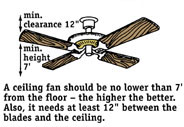 Check the Blade Clearance
Check the Blade Clearance
Check the floor-to-ceiling height of the fan blades. You can do this by measuring the floor-to-ceiling distance and subtracting for the part of
the fan that will extend below the ceiling down to the lower blade surface. An absolute minimum height of 7' is recommended. Building codes in your
area may reinforce this.
If the floor-to-ceiling distance is too little, check into a low-ceiling mount for your fan. With some models, the fan blade height can be increased
by as much as 10". Remember, though, that you need at least 12" between the ceiling and the tops of the fan blades for proper airflow. Having 18"
is better if the space is available.
|
 |
1. Turn off the Power
Start your installation by turning off the power to the light's circuit breaker or fuse. Only then should you remove the light fixture. Make sure
to read all of the electrical safety tips!
2. Determine Center
If there is no central light fixture, snap diagonal chalk lines from opposite corners of the room to find its center. Determine whether the lines
cross exactly below a ceiling joist. If they do, move aside just far enough between the joists to fasten the side of the fan's new junction box
directly to the joist.
|
 |
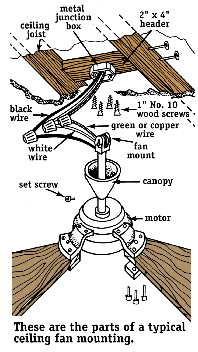 3. Install Junction Box
3. Install Junction Box
Cut a hole large enough for the junction box to be slipped in. If it's next to the joist, drill holes in its side and screw it to the joist.
Installation between joists is OK, too. Fasten the box to a 2" x 4" header nailed between the joists. Sometimes, you can insert a 2" x 4" header
through the junction box's hole, nailing it to each joist. If not, you may need to open a larger access hole. Then, patch the hole to close it again.
View the image for a typical fan mounting where there's access above the joists for header-nailing.
|
 |
 Tip:
Tip:
You may choose to use a patented fan support unit designed to be inserted through the normal junction box hole to save you from opening a hole in
the ceiling.
Use only a metal junction box to support a ceiling fan - never hang the fan from a plastic box. Depending on the brand, style, and size of your
ceiling fan - and your electrical code - you may use a 4" or 3" octagonal junction box. (Some local codes don't permit the use of 3" boxes.)
|
 Caution:
Caution:
The heaviest fan that should be supported by an outlet/junction box is 35 pounds. If it weighs more, the building structure must support it.
Also, your mounting must be able to withstand vibration while the fan is running. Even a well-balanced fan creates some vibration when it runs. |
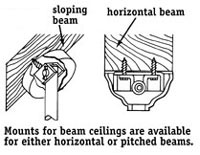 4. Mounting to a Beamed Ceiling
4. Mounting to a Beamed Ceiling
You'll use a special beam mount when mounting a fan to a beamed ceiling. Use one kind for a horizontal beam, another for a pitched beam. You may
need an extender to lower the fan to the proper level. |
 Caution:
Caution:
Fan-mounting is particularly important because any failure to make things secure could allow your fan to fall from the ceiling. |
Assemble the Fan
Fan assembly varies from brand to brand. Be sure to follow the specific instructions with the unit that you buy. Regardless of the manufacturer's
instructions, if the fan blades are less than a screwdriver's length away from the ceiling, it may be best to install the blades before hanging
the fan. |
1. Install the Hanger Pipe
The hanger pipe is usually placed into its hole on top of the motor. The wires are then drawn up in the center. A set-screw is tightened securely
to make sure the pipe stays in place after it is threaded down.
Some fans have a separate motor hub into which the hanger pipe mounts. In this case, you'll place the actual motor housing over the hub.
|
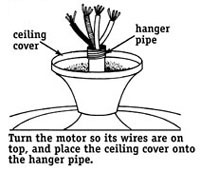 If Fan has a Decorative Ceiling Cover
If Fan has a Decorative Ceiling Cover
Other fans have a two-piece decorative ceiling cover to hide the hole in the ceiling. It is installed after the fan has been hung on the ceiling. |
 Tip:
Tip:
Tighten the setscrew well. |
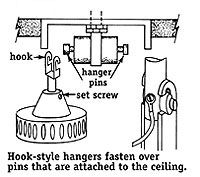 If Fan has a Hook-Style Hanger
If Fan has a Hook-Style Hanger
Other models use a hook, with the hanger bracket designed to accept it. |
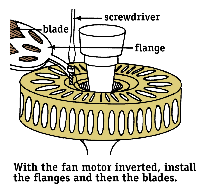 2. Attach the Fan Blades
2. Attach the Fan Blades
To attach the fan blades, set the motor unit down where it will be stable. Often, the styrene foam packing for the motor housing makes an excellent
stabilizer on your worktable.
Most fan blades have a two-pronged attachment, using screws that come through holes in the blades and into the flanges. These need to be drawn
up securely, but not so tightly that the threads are damaged or the laminated blade material is crushed. On many fans you'll find the flanges, or
prongs, also need to be mounted to the motor housing. If this is the case, mount them before the flanges are mounted to the blades themselves.
|
Mounting the Fan to the Box
1. Install Hanger Bracket
Install the hanger bracket on the box with screws and lock washers. If no lock washers are supplied, purchase them at your
local True Value store. They will help prevent fan vibration from loosening
the screws over time. |
 Tip:
Tip:
The hanger bracket may accept either a half-ball hanger or a hook-type hanger, depending on which kind your fan uses. Either way, the hanger is
carefully slipped into the bracket. |
2. Wire the Unit
Next, the unit is wired, and the ceiling cover is slipped up to its full height and tightened in place.
Be sure to connect the black house wires to the black fan wires, and the white house wires to the white fan wires. |
3. Ground the Fan
The fan should be electrically grounded to both the metal box and the fan. The grounding wires will be either green or bare copper. A green grounding
pigtail attached to the box by a bonding screw will make your work easier. Wirenut the ground wires from the box; the fan and the power supply together. |
 |
 Tip: Problem Hanging?
Tip: Problem Hanging?
- If the fan wobbles when it runs, its blades may be unbalanced. To correct this, try interchanging two adjacent blades. If that doesn't work,
take all the blades off and weigh each one on a food or postal scale. If any is underweight, tape a soft object such as a pencil eraser or modeling
clay to the top center of the blade, making its weight the same as the others. Fan balancing kits with detailed instructions are also available.
Reinstall the blades and the fan should run smoothly.
- When nothing else works for fan mounting, use a piece of good-looking hardwood plywood as a fan-mount. It should be large enough to extend
over two joists. The size may be 18" x 18" or 26" x 26", or any variant that does the job.
|
1. Attach to Joists
Use brass screws in pilot-drilled holes to attach the plywood to the ceiling joists. The screw length will vary, depending on the thickness of the
plywood and plaster or plasterboard ceiling below the joists. Use one screw every 6". |
 Tip:
Tip:
The plywood will have an access hole of proper size cut in its center, and will serve as the main mounting member for the junction box above it. |
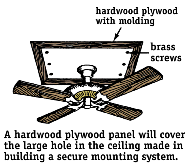 2. Install Molding
2. Install Molding
Finish the plywood with an outside corner molding, mitered at the corners for a neat appearance.
Or, you can get a surface-mounting fixture box along with a surface conduit wiring system that meets electrical codes. This allows you to do the
wiring installation on the ceiling and wall, rather than behind it. |
 Tip:
Tip:
You may wish to wire your new ceiling fan through a fan speed control. This lets you set its operating speed smoothly and easily. |
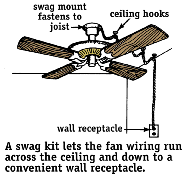 Use of Swag Wiring Kits
Use of Swag Wiring Kits
Swag kits are available if you wish to have a super-easy installation and a degree of portability in a ceiling fan. These replace the above-ceiling
wiring job. In this case, though, the hanger bracket is screwed directly into a ceiling joist.
|
1. Assembly and Wiring
The swag kit is wired into the fan, and the fan assembled as described earlier. Then slip it into the hanger bracket. |
2. Power for the Fan
The chain and cord are hung from hooks carried across the ceiling, toward a wall and down the wall, where the cord plugs into a handy receptacle. |
3. Mobility of Use
A swag-mounted ceiling fan can be taken down in a few minutes and moved to another location for greater convenience. |
 |
Electrical Safety Tips:
- Use extra care when working with electricity. Even less current than it takes to light a 60-watt bulb can be lethal.
- All wiring should conform to local electrical codes as well as to the current National Electrical Code (NEC). You can probably find a copy
of the NEC at your local library.
- Never trust a light switch to render a fixture "dead," because sometimes the power enters at the fixture, even when the switch is located
in the circuit beyond it.
- Turn off the circuit you're working on by switching off a circuit breaker or by unscrewing a fuse (the house main switch should be off when
handling fuses). Then padlock the panel if you can.
- Make sure the circuit is truly "dead" before touching any wires or terminals. Check with a high-voltage neon tester. Test from the black
wires to a grounded metal box or other good ground, then to the white wires. Also test from the white wires to a ground. Since there may be
more than one circuit inside an outlet box, before you take off a cover, see that all of its circuits are off. Also, be sure your tester is
functioning by first trying it in a live receptacle.
- Test your finished work with the power on using the neon tester. Check black to white and black to a ground. It should light. Test white
to ground. It should not light.
- If you aren't knowledgeable about working around electricity, call in a professional.
Back to top
|
 |
Tools and Materials
- Ceiling fan
- Mounting kit
- Swag kit (if applicable)
- Lock washers
- Patented support unit
- 4" x 1 1/2" octagon electrical box
- Cable
- Outlet box
- Switch
- Box connectors
- Wirenuts
- Switch cover
- Bonding screw
- Neon test light
- No. 2 Phillips screwdriver
- Claw hammer
- 3/16" slotted screwdriver
- Speed controller
- Pliers
- Wallboard or compass saw
- Soft cloth
- Stud locator
- Ladder
- Electrician's pliers
- Wire-stripper
- Cable-ripper
- Surface-wiring system
|
Note: This article was submitted by a second party and the contents are subject to our disclaimer.
|

